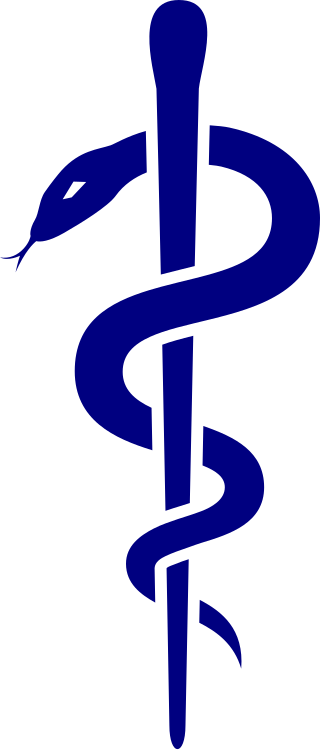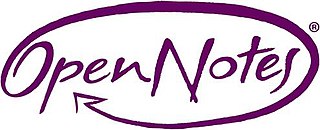
Medicine is the science and practice of caring for a patient, managing the diagnosis, prognosis, prevention, treatment, palliation of their injury or disease, and promoting their health. Medicine encompasses a variety of health care practices evolved to maintain and restore health by the prevention and treatment of illness. Contemporary medicine applies biomedical sciences, biomedical research, genetics, and medical technology to diagnose, treat, and prevent injury and disease, typically through pharmaceuticals or surgery, but also through therapies as diverse as psychotherapy, external splints and traction, medical devices, biologics, and ionizing radiation, amongst others.
Palliative care is an interdisciplinary medical caregiving approach aimed at optimizing quality of life and mitigating suffering among people with serious, complex, and often terminal illnesses. Within the published literature, many definitions of palliative care exist. The World Health Organization (WHO) describes palliative care as "an approach that improves the quality of life of patients and their families facing the problems associated with life-threatening illness, through the prevention and relief of suffering by means of early identification and impeccable assessment and treatment of pain and other problems, physical, psychosocial, and spiritual". In the past, palliative care was a disease specific approach, but today the WHO takes a broader patient-centered approach that suggests that the principles of palliative care should be applied as early as possible to any chronic and ultimately fatal illness. This shift was important because if a disease-oriented approach is followed, the needs and preferences of the patient are not fully met and aspects of care, such as pain, quality of life, and social support, as well as spiritual and emotional needs, fail to be addressed. Rather, a patient-centered model prioritizes relief of suffering and tailors care to increase the quality of life for terminally ill patients.

In a physical examination, medical examination, or clinical examination, a medical practitioner examines a patient for any possible medical signs or symptoms of a medical condition. It generally consists of a series of questions about the patient's medical history followed by an examination based on the reported symptoms. Together, the medical history and the physical examination help to determine a diagnosis and devise the treatment plan. These data then become part of the medical record.

The terms medical record, health record and medical chart are used somewhat interchangeably to describe the systematic documentation of a single patient's medical history and care across time within one particular health care provider's jurisdiction. A medical record includes a variety of types of "notes" entered over time by healthcare professionals, recording observations and administration of drugs and therapies, orders for the administration of drugs and therapies, test results, X-rays, reports, etc. The maintenance of complete and accurate medical records is a requirement of health care providers and is generally enforced as a licensing or certification prerequisite.
The medical history, case history, or anamnesis of a patient is a set of information the physicians collect over medical interviews. It involves the patient, and eventually people close to him, so to collect reliable/objective information for managing the medical diagnosis and proposing efficient medical treatments. The medically relevant complaints reported by the patient or others familiar with the patient are referred to as symptoms, in contrast with clinical signs, which are ascertained by direct examination on the part of medical personnel. Most health encounters will result in some form of history being taken. Medical histories vary in their depth and focus. For example, an ambulance paramedic would typically limit their history to important details, such as name, history of presenting complaint, allergies, etc. In contrast, a psychiatric history is frequently lengthy and in depth, as many details about the patient's life are relevant to formulating a management plan for a psychiatric illness.
Step 2 Clinical Skills of the United States Medical Licensing Examination (USMLE) was an exam administered to medical students/graduates who wish to become licensed physicians in the U.S. It is similar to the COMLEX-USA Level 2-PE exam, taken by osteopathic medical students/graduates who seek licensure as physicians in the U.S. For US medical students, the exam fee is $1,300. For medical students at non-US medical schools, the tests cost is higher—currently $1,535. These fees do not include costs associated with travel and lodging to take the test. Historically, US students have taken Step 2 CS late in their senior year, prior to graduation. However, now that more residency programs require students to record a passing score, many US medical schools recommend students take Step 2 CS in the fall of their senior year.
Nursing assessment is the gathering of information about a patient's physiological, psychological, sociological, and spiritual status by a licensed Registered Nurse. Nursing assessment is the first step in the nursing process. A section of the nursing assessment may be delegated to certified nurses aides. Vitals and EKG's may be delegated to certified nurses aides or nursing techs. It differs from a medical diagnosis. In some instances, the nursing assessment is very broad in scope and in other cases it may focus on one body system or mental health. Nursing assessment is used to identify current and future patient care needs. It incorporates the recognition of normal versus abnormal body physiology. Prompt recognition of pertinent changes along with the skill of critical thinking allows the nurse to identify and prioritize appropriate interventions. An assessment format may already be in place to be used at specific facilities and in specific circumstances.
A nursing care plan provides direction on the type of nursing care the individual/family/community may need. The main focus of a nursing care plan is to facilitate standardised, evidence-based and holistic care. Nursing care plans have been used for quite a number of years for human purposes and are now also getting used in the veterinary profession. A care plan includes the following components: assessment, diagnosis, expected outcomes, interventions, rationale and evaluation.
Health technology is defined by the World Health Organization as the "application of organized knowledge and skills in the form of devices, medicines, vaccines, procedures, and systems developed to solve a health problem and improve quality of lives". This includes pharmaceuticals, devices, procedures, and organizational systems used in the healthcare industry, as well as computer-supported information systems. In the United States, these technologies involve standardized physical objects, as well as traditional and designed social means and methods to treat or care for patients.
Reactive airway disease (RAD) is an informal label that physicians apply to patients with symptoms similar to those of asthma. An exact definition of the condition does not exist. Individuals who are typically labeled as having RAD generally have a history of wheezing, coughing, dyspnea, and production of sputum that may or may not be caused by asthma. Symptoms may also include, but are not limited to, coughing, shortness of breath, excess mucus in the bronchial tube, swollen mucous membrane in the bronchial tube, and/or hypersensitive bronchial tubes. Physicians most commonly label patients with RAD when they are hesitant about formally diagnosing a patient with asthma, which is most prevalent in the pediatric setting. While some physicians may use RAD and asthma synonymously, there is controversy over this usage.
Medical model is the term coined by psychiatrist R. D. Laing in his The Politics of the Family and Other Essays (1971), for the "set of procedures in which all doctors are trained". It includes complaint, history, physical examination, ancillary tests if needed, diagnosis, treatment, and prognosis with and without treatment.
An admission note is part of a medical record that documents the patient's status, reasons why the patient is being admitted for inpatient care to a hospital or other facility, and the initial instructions for that patient's care.
Progress Notes are the part of a medical record where healthcare professionals record details to document a patient's clinical status or achievements during the course of a hospitalization or over the course of outpatient care. Reassessment data may be recorded in the Progress Notes, Master Treatment Plan (MTP) and/or MTP review. Progress notes are written in a variety of formats and detail, depending on the clinical situation at hand and the information the clinician wishes to record. One example is the SOAP note, where the note is organized into Subjective, Objective, Assessment, and Plan sections. Another example is the DART system, organized into Description, Assessment, Response, and Treatment. Documentation of care and treatment is an extremely important part of the treatment process. Progress notes are written by both physicians and nurses to document patient care on a regular interval during a patient's hospitalization.

Medical diagnosis is the process of determining which disease or condition explains a person's symptoms and signs. It is most often referred to as diagnosis with the medical context being implicit. The information required for diagnosis is typically collected from a history and physical examination of the person seeking medical care. Often, one or more diagnostic procedures, such as medical tests, are also done during the process. Sometimes the posthumous diagnosis is considered a kind of medical diagnosis.
A review of systems (ROS), also called a systems enquiry or systems review, is a technique used by healthcare providers for eliciting a medical history from a patient. It is often structured as a component of an admission note covering the organ systems, with a focus upon the subjective symptoms perceived by the patient. Along with the physical examination, it can be particularly useful in identifying conditions that do not have precise diagnostic tests.
In a medical encounter, a past medical history, is the total sum of a patient's health status prior to the presenting problem.
AHLTA is a global Electronic Health Record (EHR) system used by U.S. Department of Defense (DoD). It was implemented at Army, Navy and Air Force Military Treatment Facilities (MTF) around the world between January 2003 and January 2006. It is a services-wide medical and dental information management system. What made AHLTA unique was its implementation date, its Central Data Repository, its use in operational medicine and its global implementation. There is nothing like it in the private sector.
The Clinical Care Classification (CCC) System is a standardized, coded nursing terminology that identifies the discrete elements of nursing practice. The CCC provides a unique framework and coding structure. Used for documenting the plan of care; following the nursing process in all health care settings.
A medical scribe is an allied health paraprofessional who specializes in charting physician-patient encounters in real time, such as during medical examinations. They also locate information and patients for physicians and complete forms needed for patient care. Depending on which area of practice the scribe works in, the position may also be called clinical scribe, ER scribe or ED scribe, or just scribe. A scribe is trained in health information management and the use of health information technology to support it. A scribe can work on-site or remotely from a HIPAA-secure facility. Medical scribes who work at an off-site location are known as virtual medical scribes.

OpenNotes is a research initiative and international movement located at Beth Israel Deaconess Medical Center.




